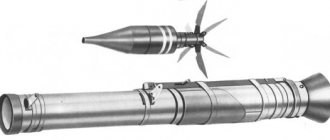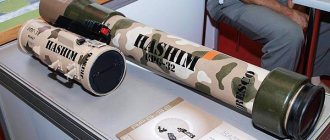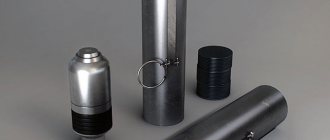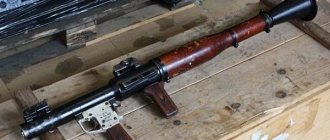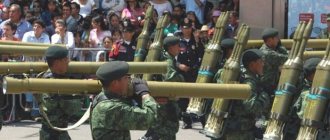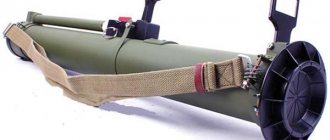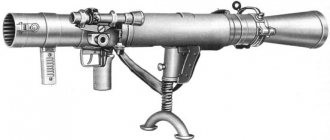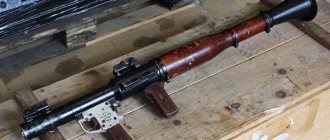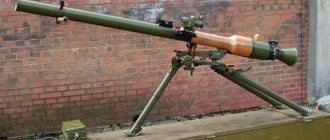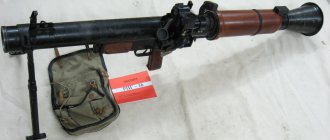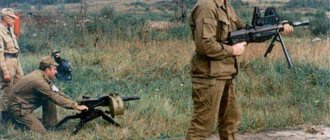Domestic disposable grenade launchers
In the 70s, another type of grenade launcher was created in the Soviet Union - disposable. One of the types of ammunition for disposable grenade launchers are multi-purpose and assault grenades. A rocket-propelled anti-tank grenade with a disposable launcher to replace the RKG-3 anti-tank hand grenade came into development in the Soviet Union in 1967. There is an assumption that the start of development was due to the fact that the Soviet military became familiar with the American M72 LAW system of a similar type, which was actively used by the Americans during the Vietnam War. At the very least, the layout and basic design decisions of this weapon, which entered service with the Soviet troops in 1972, indicated that it was an analogue of the M72 LAW. During development, the RPG-18 received the code name “Mukha” and was produced until the early 90s. At this point in time, “Mukha” is recognized as an obsolete model. Therefore, it was replaced with newer and more efficient models.
The RPG-18 anti-tank rocket grenade is a rocket projectile with a 64 mm caliber cumulative warhead and a powder jet engine. The grenade's flight path is stabilized using folding stabilizers, as well as the axial rotation that these stabilizers provide. The grenade flies out with an initial speed of about 115 meters per second. The starting device is a telescopic structure consisting of an internal aluminum pipe. It is fitted with a nozzle that is moved forward and thus protects the shooter from engine exhaust during operation. There are hinged covers on the sides of the starting device. In order to bring the gun into a firing position, you need to pull out the safety pin and move the launch container into the firing position. In this case, the end flaps slide apart automatically. The ammunition is launched by pressing the trigger lever. Since it is impossible to return a grenade launcher brought into firing position to its original position, after platooning it must be fired: either towards the enemy, or in the safest direction. During a shot, a dangerous zone up to 30 meters deep is formed behind the shooter.
Based on the RPG-18, the RPG-22 anti-tank rocket-propelled grenade was developed. Development was carried out in the late 70s, during which the weapon was given the code name "Net". “Netto” was put into service in 1980, and production continued until 1993. The RPG-22 surpasses its predecessor in armor penetration and direct shot range thanks to a more powerful rocket engine and increased initial speed. It also differs in its smaller dimensions.
The RPG-22 is a rocket with a 72.5 mm caliber cumulative action warhead and a jet powder engine. The main technical characteristics are identical to the RPG-18. The initial speed of the grenade is approximately 130 meters per second. Firing accuracy has also been increased - it is 0.4 m. In addition, a change in the firing mechanism made it possible to re-cock the hammer in case of a misfire. There is no recoil when firing from this weapon. This is achieved due to the fact that the powder gases exit through the open barrel back. The grenade is fired using a jet engine. Its powder fuse burns out completely as the grenade moves down the barrel.
In parallel with the adoption of the RPG-22 in 1980, development began on another type of disposable grenade launcher - the RPG-26. During the work, it was given the code name “Aglen”. The main objective of developing a new weapon was to simplify the return of the grenade to the stowed position from the combat position and increase the level of target destruction. Soviet troops adopted it for service in 1985. Over time, the RPG-26 completely replaced the outdated RPG-18 and RPG-22 grenade launchers.
This type of weapon is still produced and in service with the Russian armed forces as an individual means of combat for infantrymen against armored vehicles and light fortifications.
The RPG-26 anti-tank rocket-propelled grenade is a rocket projectile with a 72.5 mm caliber cumulative action warhead and a jet powder engine. The grenade's flight path is stabilized thanks to folding stabilizers and axial rotation. The starting device is made in the form of a fiberglass monoblock pipe. When leaving the launcher, the grenade has a speed of approximately 145 meters per second. The trigger device is closed at the ends with rubber covers that collapse during the shot.
To bring the weapon into firing position, you only need to pull out the safety pin. In this case, the trigger mechanism is cocked, and the ammunition is launched by pressing the trigger lever.
In order to transfer a grenade from the firing position to its original position, it is necessary to remove the firing mechanism from the firing position by lowering the rear sight horizontally and fixing it with a pin.
In the mid-80s, development was also carried out on the RPG-27 anti-tank rocket-propelled grenade, which was called “Meadowsweet”. The main objective of the development was to ensure the effective destruction of modern tanks that had dynamic protection and reinforced armor. For this purpose, warheads from the PG-7VR grenade launcher RPG-7V were used in the design of the weapon. It was adopted by the Soviet armed forces as a complement to the more compact and lighter, but at the same time less effective RPG-26. Anti-tank rocket-propelled grenades RPG-27 are still in service with Russian troops and are also produced for export. The grenade is propelled by a jet engine.
The RPG-27 launcher is practically no different from the RPG-26 and is a fiberglass tube. The sights and trigger mechanism are also similar. Near the rear edge there is a folding rest for prone shooting. During shooting, it is placed on the ground. This allows you to keep the barrel at such a distance from the surface that grenades do not touch it when they fly out. In order to increase the penetrating effect of the grenade, it is made of a tandem type: the main part has a caliber of 105 millimeters, and the front part has a caliber of 64 millimeters. The front part is triggered when interacting with the tank's dynamic protection, destroying it and sending a signal to the main warhead. The mass of the grenade launcher is 7.5 kilograms, the initial speed of the grenade upon departure is 130 meters per second, the firing range at a height of 2 meters is approximately 150 meters.
Based on the RPG-27 anti-tank rocket-propelled grenade, the RShG-1 assault rocket-propelled grenade was developed. The main difference between them is the RShG-1 thermobaric warhead, which is used to combat enemy fortifications and infantry, as well as lightly armored vehicles. In terms of the method of influencing the target, the RShG-1 is very similar to the RPO-A infantry jet flamethrower, but through a different classification it enters service with conventional infantry troops, and not chemical troops. It has been in service with Russian troops since 2000, and is also produced for export.
RShG-1 is a rocket projectile with a thermobaric warhead of 105 mm caliber and a jet powder engine. The warhead contains about 1.9 kilograms of fuel mixture. When detonated, it produces a high-explosive effect, which can be compared to detonating 6 kilograms of TNT. The grenade's flight path is leveled thanks to folding stabilizers and the axial rotation that they transmit to the grenade. The initial speed of the grenade upon departure is approximately 120 meters per second. The trigger device is covered at the ends with rubber caps that collapse when fired. Transferring a grenade from its firing position to its original position is similar to the RPG-27.
At the same time, development of the RShG-2 was carried out, and in 2000 it was adopted by the Russian armed forces. The RShG-2 assault rocket grenade was developed on the basis of the RPG-26. The only difference between them is the use of a thermobaric warhead in the RShG-2.
The RShG-2 assault rocket grenade is a rocket projectile with a thermobaric warhead of 72.5 mm caliber and a jet powder engine. The warhead contains about 1.16 kilograms of a fuel mixture, the explosion of which is equivalent to the explosion of 3 kilograms of TNT. The warhead has simultaneously high cumulative, high-explosive, fragmentation and incendiary effects. The design of RShG-2 has no analogues in the world.
A characteristic feature of the grenade is its ability to hit enemy personnel hidden in structures, even if they are armored and even if the grenade hits an embrasure indirectly. RShG-2 is capable of breaking through concrete walls up to 300 millimeters and brick walls up to 500 millimeters.
The universal modules that were used in the design made it possible to significantly reduce the costs of development and introduction into mass production. It is also important to note that mastering the process of using a grenade in combat is not difficult. Experts are confident that, based on the price-effectiveness principle, this type of weapon has no analogues in the world.
Video RPG-30 Hook
The Russian Ministry of Defense has determined the timing of delivery to combat units of new double-barreled hand-held anti-tank grenade launchers - RPG-30 "Hook", created at NPO Basalt. In 2009, the new grenade launcher successfully passed a series of state tests, after which a decision was made to supply these grenade launchers to the Russian army. The delivery of new RPGs to the troops will begin in November 2013. According to the Izvestia newspaper, the military purchased 1,000 grenade launchers. The amount of the contract for the supply of RPG-30 (was concluded at the end of 2012) amounted to 83 million rubles, which means the cost of each grenade launcher is 83 thousand rubles. The first thousand new RPGs will be transferred to district warehouses of the Central and Southern Military Districts, from where the grenade launchers will be transferred to the brigades.
The RPG-30 “Hook” anti-tank grenade launcher (GRAU index 7P53) is a single-use, two-tube weapon. A 105-mm tandem cumulative anti-tank grenade PG-30 is located in a cylindrical container of larger diameter. Below is a container of smaller diameter in which the target simulator is located. Its purpose is to activate enemy active defense means when approaching a target and to ensure conditions under which the main tandem ammunition can easily destroy the target. The new Russian RPG-30 "Hook" grenade launcher is superior to its predecessor RPG-29 "Vampire" in compactness - the length is just over 1 meter, versus 2 meters for the "Vampire". At the same time, the RPG-29 has proven itself quite well in modern military conflicts, for example, in Syria, where it has repeatedly demonstrated amazing penetrating power. The RPG-22 and RPG-26 grenade launchers in service with the Russian army cost the budget approximately 30 thousand rubles apiece. The “hook” costs 2.5 times more, but this is a justified waste of money.
The army notes that the transition to the new RPG-30 grenade launcher should not be accompanied by any difficulties for personnel. Of course, the new grenade launcher, due to the presence of 2 barrels, requires a special grip and at first it may seem that it is inconvenient to hold it, but soldiers get used to this feature after a couple of training sessions. The peculiarity of the grenade launcher is that the simulator in it is quite fragile, which means the RPG-30 must be used quite carefully, noted an officer of the missile and artillery weapons service of the Southern Military District.
According to Vitaly Moiseev, editor of the Courage-2004 website, the acquisition of the latest Russian grenade launcher is another step in continuing the eternal confrontation between defense and attack technology. The Russian armed forces must be prepared to fight any enemy that has outdated or, on the contrary, high-tech weapons. Perhaps in the very near future the number of countries that equip their armored vehicles with active protection systems will increase many times over. In this regard, the Russian military’s availability of such a weapon as the RPG-30 “Hook” would be appropriate. The development of a new means of destroying enemy tanks and armored vehicles began at the state research and production enterprise "Basalt" back in the mid-2000s. The newest RPG-30 "Hook" was developed to destroy all types of armored vehicles in service, as well as advanced models, as well as unarmored targets, enemy personnel and protected fortifications and firing points on the battlefield. This anti-tank weapon system is able to overcome all possible active protection systems (APS) of tanks and other armored vehicles that were developed by the beginning of the 21st century in various countries of the world.
The RPG-30 grenade launcher is, of course, a new means of combating enemy armored vehicles. The use of a special type of armor against warheads with a shaped charge has been known for a long time. This type of armor is called active-reactive armor and consists of exploding plates that form a common detonation chain. At the moment the projectile hits the plate, detonation occurs, which affects the cumulative charge jet. At this moment, the jet deviates from the position of primary contact with the target’s armor, which significantly reduces the effect of its impact.
The attacker's response was the use of tandem rocket munitions. The warhead of such projectiles consists of 2 parts: an initial charge, which acts as a detonator for reactive armor plates, and a main charge, which is triggered after a specified period of time at the moment when the target is already deprived of dynamic protection. However, the designers also found solutions for tandem ammunition. The next step was the development of active protection systems. Examples of such systems include the well-known Russian “Arena”, the widely advertised Israeli “Trophy” system, as well as the promising American development FCLAS. These systems detect a shot approaching a tank and launch a projectile to meet it, achieving the destruction or detonation of anti-tank ammunition by impact or explosive action. For these purposes, dense inert metal elements can be used, which at the moment of explosion scatter in the air like microshrapnel. It is assumed that this type of defense has a limited radius of destruction and cannot harm its own troops located nearby.
The RPG-30 grenade launcher is equipped with 105 mm tandem ammunition, which is capable of penetrating steel armor more than 600 mm thick behind the dynamic protection. The main distinguishing feature of the grenade launcher is the use of a 2nd tube, from which a smaller caliber decoy missile is fired. This decoy missile is a part of a real missile that is ahead of the main warhead on approach to the target. The essence of this idea is that the tank's active protection system destroys the missile simulator and cannot immediately hit the second, real threat. According to Russian experts, well-known KAZs are able to destroy a second target after a minimum time interval of 0.2-0.4 s. At the same time, the PG-30 grenade approaches the target in less time, which leaves all active protection systems out of work.
The RPG-30 “Hook” grenade launcher was created using a unique and innovative bi-caliber design for hand-held anti-tank weapons, using a target simulator. Structurally, it consists of 2 parallel pipes of different diameters, in which rockets are placed. The ends of both pipes are covered with petal-shaped rubber membranes, which are destroyed at the moment of firing. The grenade launcher is equipped with a single aiming device and trigger mechanism. The RPG-30 is equipped with a folding mechanical sight. The grenade launcher is brought into firing position by raising the sight bar and cocking the trigger mechanism. The larger container contains the main 105-mm tandem cumulative rocket-propelled anti-tank grenade PG-30, which largely replicates similar ammunition for the earlier version of the RPG-29 “Vampire” grenade launcher. This grenade launcher managed to prove itself quite well in the defeat of Israeli Merkava tanks during the second Lebanon War, as well as the American M1A2 Abrams and British Challenger 2 during the second Iraqi campaign. The smaller diameter container contains a target simulator missile. It has a trajectory identical to the main grenade, as well as a radar signature. The tank's active defense means detect it as a rocket-propelled grenade attacking the tank and trigger the system.
Operating principle of RPG-30
Being at firing distance (target range 200 meters) to the enemy’s armored target, the grenade launcher takes aim and fires a shot from the RPG-30 “Hook”. At the moment of firing, the propellant charges of both projectiles are triggered. In this case, the target simulator comes out of the barrel first, after which the main PG-30 ammunition starts with a slight delay. Modern KAZ tanks, when triggered by a simulator shell, are unable to react to the main anti-tank grenade that follows it. As a result, the main cumulative ammunition penetrates the main layer of armor, affects the equipment and crew inside the tank, causes a fire and detonates the ammunition.
